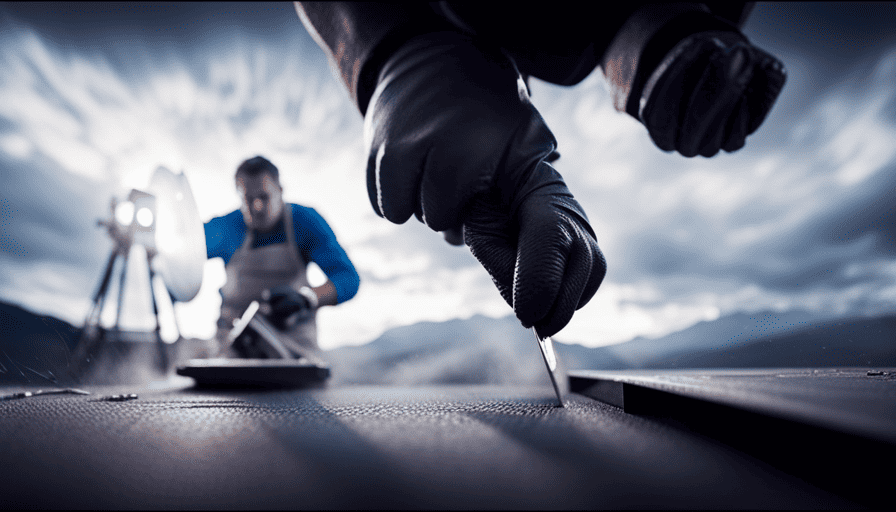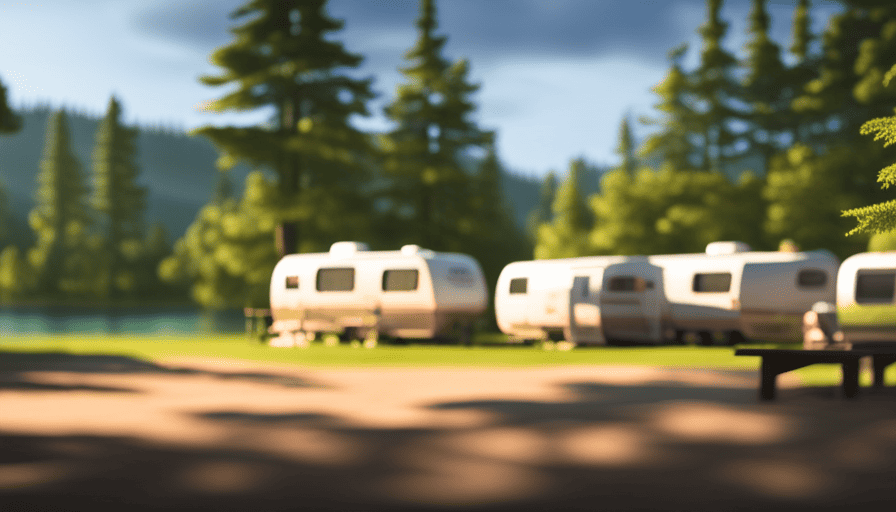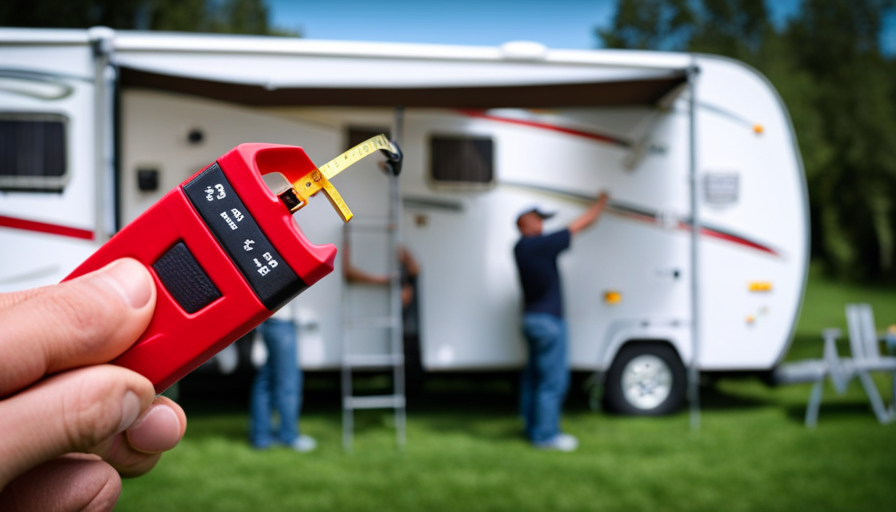Have you ever walked on a camper floor and experienced it yielding under your feet? It’s a disheartening sensation in every sense of the word. Soft areas on a camper floor often stem from issues like water damage or decay. However, worry not, for I am here to show you the way to mend those troublesome soft areas and bring your camper floor back to its original, solid state.
First, we need to identify the location of the soft spot. It’s like finding a hidden treasure, but instead of gold, we’re searching for weak spots in the floor. Once located, we’ll inspect for water damage or rot, ensuring we fully understand the extent of the problem.
Next, it’s time to roll up our sleeves and get to work. We’ll remove the damaged flooring, exposing the subflooring that lies beneath. Depending on the severity of the damage, we may need to repair or replace the subflooring altogether.
To reinforce the subflooring, we’ll use techniques that will make it stronger than ever. Then, we’ll seal and finish the new flooring, giving it a polished and professional look.
Of course, the proof is in the pudding, or in this case, the repaired area. We’ll conduct a thorough test to ensure our fix is solid and durable.
Lastly, we’ll discuss preventive measures to avoid future soft spots, so you can enjoy your camper floor worry-free.
So, grab your tools and let’s dive into the world of camper floor repair. Together, we’ll make your floor sturdy and solid once again!
Key Takeaways
- Soft spots in camper floors are typically caused by water damage or rot, which can be identified through signs such as discoloration, warping, musty odor, and mold growth.
- Immediate action is necessary to prevent further damage and maintain the value of the camper.
- Repairing or replacing the subflooring is essential to eliminate the source of the problem, with the extent of the damage determining the method used (patching compound or removal and replacement with new plywood).
- When fixing soft spots in camper floors, it’s important to consider factors such as the choice between adhesive and screws for securing the floor, the type of flooring material to use (laminate flooring is popular due to its durability and easy maintenance), and the application of a waterproof sealant or coating to protect the new flooring from moisture damage.
Identify the Location of the Soft Spot
To identify the location of the soft spot in your camper floor, you’ll need to carefully inspect the affected area and use your senses to detect any changes in texture or stability. Start by stepping on different sections of the floor and pay attention to any sinking or bouncing sensations. This will help you pinpoint the exact location of the soft spot.
Once you’ve located the soft spot, it’s important to take immediate action to prevent further damage and maintain the value of your camper. Ignoring the issue can lead to more extensive repairs and a decrease in resale value.
To patch the soft spot in your camper floor, you’ll need to remove any furniture or coverings that may be obstructing your access to the affected area. Use a flashlight to inspect for water damage or rot, as these can be indicators of the underlying cause of the soft spot. Look for dark discoloration, mold, or a musty odor, as these are signs of water infiltration. Repairing soft spots in camper floor is a relatively simple process that can be done with the right materials and tools. Once you have identified the source of the soft spot, you can begin to cut out the affected area using a jigsaw or utility knife. Replace the damaged section with a new piece of plywood and secure it in place with wood screws. Finally, sand down the edges and apply a sealant to prevent future water damage. If you suspect that the soft spot in your camper floor is the result of a leak from your propane heater, it may be best to consult with a professional to ensure the safety of your repair. Additionally, it’s important to regularly inspect and maintain your propane heat in camper to prevent future leaks and damage to your flooring. By taking these precautions, you can ensure the longevity and safety of your camper for future adventures.
By properly identifying and addressing the soft spot in your camper floor, you can prevent further damage and ensure the longevity and value of your camper. Inspect for water damage or rot to determine the appropriate steps for repair and restoration.
Inspect for Water Damage or Rot
Examine the area carefully to identify any signs of water damage or decay in your camper’s flooring. Start by visually inspecting the soft spot and surrounding areas for discoloration, warping, or a musty odor. These are common indicators of water damage.
Use a moisture meter to detect hidden leaks and determine the extent of the damage. Moisture meters are handy tools that can help pinpoint the source and severity of the problem.
Next, examine the affected area for any signs of rot. Gently press on the soft spot to check for sponginess or a lack of support. If the floor feels mushy or gives way, it’s likely that rot has set in. Look for dark or discolored wood, as this may indicate decay.
Additionally, inspect the underside of the camper for any visible signs of water infiltration, such as water stains or mold growth.
To prevent further damage and mold growth, it’s crucial to address any water damage or rot promptly. By removing the damaged flooring, you can eliminate the source of the problem and begin the repair process.
Remove Damaged Flooring
Carefully assess the affected area for any indications of damage or decay in the flooring of your camper. Look for soft spots, discoloration, or any signs of water damage. It’s important to identify the extent of the problem before proceeding with any repair techniques or floor restoration.
To remove the damaged flooring, follow these steps:
- Start by removing any furniture or fixtures that may be in the way.
- Use a utility knife to cut through the flooring along the edges of the damaged area.
- Carefully pry up the damaged flooring using a pry bar or a flathead screwdriver.
- Dispose of the damaged flooring properly.
Once the damaged flooring is removed, you can move on to the next step of repairing or replacing the subflooring. This will ensure that your camper’s floor is sturdy and safe for use.
Repair or Replace Subflooring
After removing the damaged flooring, it’s time to roll up my sleeves and get to work on giving the subflooring a much-needed facelift.
Repairing or replacing the subflooring in a camper requires some specific techniques and materials. First, I need to assess the extent of the damage and determine whether the subflooring can be repaired or needs to be completely replaced.
If the damage is minimal, I can use a patching compound to fill in any cracks or holes in the subflooring. However, if the damage is extensive, I will need to remove the damaged sections and replace them with new plywood.
To repair the subflooring, I will need a few materials. These include a circular saw, a pry bar, plywood, adhesive, screws, a drill, and a tape measure.
Once I have gathered all the necessary materials, I can begin the repair process. I will start by cutting out the damaged sections of the subflooring using a circular saw. After removing the damaged pieces, I will then cut new plywood to fit the area and secure it in place using adhesive and screws. Finally, I will use a tape measure to ensure that the new subflooring is level and flush with the surrounding floor.
With the subflooring repaired or replaced, it’s time to reinforce it to ensure its durability and longevity.
Reinforce the Subflooring
To reinforce the subflooring in my camper, I would first add support beams or joists to provide additional stability. These beams or joists can be installed underneath the subflooring to help distribute weight evenly and prevent further sagging or soft spots.
Additionally, I would use strong adhesive or screws to secure the subflooring to the support beams or joists, ensuring a secure and sturdy foundation.
By implementing these measures, I can effectively reinforce the subflooring and restore the structural integrity of my camper floor.
Add Support Beams or Joists
First things first, let’s beef up the camper floor by adding some sturdy support beams or joists. By doing so, we can add additional support and reinforce weak areas of the floor.
Start by identifying the weak spots in the subflooring and mark them for the placement of the support beams or joists. Measure and cut the beams or joists according to the dimensions needed.
Place them perpendicular to the floor joists, ensuring they’re evenly spaced and securely fastened. Use strong adhesive or screws to secure them in place, creating a solid foundation for the camper floor. This’ll help distribute the weight more evenly and prevent further damage.
Now, let’s move on to the next step of using strong adhesive or screws to further strengthen the floor.
Use Strong Adhesive or Screws
Now, it’s time to secure your camper floor with some serious bonding power or sturdy screws, ensuring a rock-solid foundation that will leave you feeling confident and worry-free. When it comes to fixing a soft spot in your camper floor, you have two main options: using a strong adhesive or screws. Let’s compare the pros and cons of each method in the table below:
| Strong Adhesive | Screws |
|---|---|
| Provides a strong bond | Offers a secure hold |
| Easy to apply | Requires drilling |
| Can be used on various materials | May cause damage if not installed properly |
Both strong adhesive and screws have their advantages and drawbacks. Ultimately, the choice depends on personal preference and the specific needs of your camper. Once you have secured the floor, you can move on to the next step of installing new flooring.
Install New Flooring
Start by ripping out the old, worn flooring in your camper and imagine the fresh, new surface waiting to be installed. Installing laminate is a popular choice for camper flooring due to its durability and easy maintenance. When choosing the right flooring material, consider factors such as moisture resistance and ease of installation.
Laminate flooring is a great option as it’s resistant to water damage and can withstand the wear and tear of camping adventures.
To install the new flooring, follow these steps:
-
Measure the dimensions of your camper floor and purchase enough laminate flooring to cover the entire area.
-
Prepare the subfloor by ensuring it’s clean and level. Remove any debris or old adhesive.
-
Begin installation by laying down an underlayment, such as foam or cork, to provide cushioning and moisture protection.
-
Lay the laminate flooring planks, starting from one corner and working your way across the floor. Use spacers to maintain a consistent gap between the planks for expansion.
-
Secure the planks together using the manufacturer’s recommended installation method, usually a click-lock system or adhesive.
With the new flooring installed, you’re now ready to seal and finish the surface to protect it from spills and stains.
Seal and Finish the New Flooring
After installing new flooring in my camper, I make sure to apply a waterproof sealant or coating to protect it from any potential moisture damage. This step is crucial to ensure the longevity of the flooring and to prevent any water seepage or leaks.
Additionally, I add a protective finish or wax to further enhance the durability and appearance of the new flooring, providing an extra layer of protection against scratches and wear and tear.
Apply a Waterproof Sealant or Coating
To address the soft spot in your camper floor, you can enhance its durability by applying a waterproof sealant or coating. Waterproofing methods are crucial to protect the floor from moisture damage and prevent future soft spots. The best sealants for camper floors are those specifically designed for waterproofing and offering long-lasting protection. These sealants create a waterproof barrier that prevents water from seeping into the floor and causing further damage. Additionally, they can help to strengthen the weakened areas and restore the floor’s structural integrity. To help you choose the right sealant for your camper floor, refer to the table below:
| Sealant Type | Features |
|---|---|
| Polyurethane | Durable and flexible, provides excellent waterproofing. |
| Epoxy | Strong and resistant to water, chemicals, and abrasion. |
| Silicone | Forms a waterproof and flexible seal, ideal for joints and seams. |
| Acrylic | Quick-drying and easy to apply, offers decent waterproofing. |
By applying a waterproof sealant or coating, you can effectively protect your camper floor from moisture and prevent any further soft spots. In the next section, we will discuss how to add a protective finish or wax to further enhance the durability of your camper floor.
Add a Protective Finish or Wax
Enhance the durability of your camper floor by adding a protective finish or wax. This creates a barrier that safeguards against moisture and provides long-lasting protection.
When it comes to protective finish alternatives, there are various options available. For example, polyurethane is a popular choice that offers excellent resistance to water and wear. It forms a durable coating that prevents moisture from seeping into the floor, ensuring its longevity.
On the other hand, waxing the camper floor has its own benefits. Wax helps to seal the wood, making it resistant to water and providing a glossy finish. Additionally, waxing adds a layer of protection against scratches and stains.
By applying a protective finish or wax, you can significantly extend the lifespan of your camper floor. Once the finish or wax has been applied, it’s important to test the repaired area to ensure its effectiveness in preventing moisture damage.
Transitioning into the subsequent section of ‘test the repaired area’, it is crucial to verify that the protective barrier is working as intended.
Test the Repaired Area
Check if the repaired area in your camper floor is stable and secure by giving it a gentle tap. Testing the repaired area is crucial to ensure that the soft spot has been effectively addressed.
There are a few testing techniques you can use to determine the stability of the floor. First, you can walk over the repaired area and pay attention to any signs of flexing or sinking. If the floor feels solid and stable, it’s a good indication that the repair has been successful.
Another technique is to place a heavy object, such as a toolbox or a piece of furniture, on top of the repaired area and see if it causes any further sinking or creaking.
Soft spots in camper floors can be caused by various factors, such as water damage, inadequate support, or structural issues. By testing the repaired area, you can identify the effectiveness of the repair and whether any underlying issues still persist.
To prevent future soft spots, it’s important to address the root cause of the problem. This may involve reinforcing the floor with additional support, repairing any leaks or water damage, or consulting a professional for structural repairs. By taking proactive measures, you can ensure the long-term stability and durability of your camper floor.
Prevent Future Soft Spots
After you have tested the repaired area and ensured that it is sturdy and solid, it is important to take steps to prevent future soft spots in your camper floor. Regular maintenance and choosing the right materials for camper flooring are key to keeping your floor in optimal condition.
To help you with camper floor maintenance, I have prepared a table with some useful tips:
| Tip | Description |
|---|---|
| Clean regularly | Regularly sweep and mop your camper floor to prevent dirt and moisture buildup. |
| Inspect for leaks | Check for any signs of water leaks and address them promptly. |
| Use proper ventilation | Ensure adequate airflow in your camper to prevent moisture accumulation. |
| Avoid heavy furniture | Use lightweight or foldable furniture to minimize stress on the floor. |
| Choose the right materials | Opt for durable and water-resistant materials for your camper flooring. |
| Invest in good insulation | Proper insulation can help prevent temperature fluctuations and moisture buildup. |
By following these camper floor maintenance tips and choosing the right materials, you can ensure the longevity and durability of your camper floor. Now, let’s move on to the next section and enjoy your sturdy and solid camper floor!
Enjoy Your Sturdy and Solid Camper Floor!
Now that you have a solid foundation beneath you, it’s time to kick up your heels and revel in the stability of your camper floor. Maintaining a solid camper floor is crucial for the longevity and enjoyment of your camper.
One important aspect of maintaining a solid floor is choosing the right flooring materials. When it comes to choosing the right flooring materials for your camper, durability is key. Look for materials that are specifically designed for high traffic areas and are resistant to water damage. Vinyl or laminate flooring are popular choices as they’re both durable and easy to clean. Additionally, they provide a stylish and modern look to your camper.
To ensure your camper floor remains solid, it’s important to regularly inspect and repair any signs of wear or damage. Keep an eye out for any soft spots or sagging areas and address them promptly. Regularly clean and remove any debris that may accumulate on the floor to prevent potential damage.
By maintaining a solid camper floor and choosing the right flooring materials, you can enjoy your camper with peace of mind, knowing that it’ll provide a sturdy and stable foundation for all your adventures. So go ahead, hit the road and enjoy the comfort and reliability of your camper floor!
Frequently Asked Questions
How long does it typically take to identify the location of a soft spot in a camper floor?
Typically, it takes some time to locate a soft spot in a camper floor. First, I would thoroughly inspect the floor, looking for any visible signs of damage or sagging.
Then, I would use a moisture meter to check for any high moisture levels that could indicate a soft spot.
Additionally, I might gently tap the floor with a hammer to listen for any hollow sounds.
By following these steps, I can accurately identify the location of a soft spot in a camper floor.
Are there any signs or indicators that water damage or rot may be present in the soft spot area?
In my experience, there are several signs and indicators that can suggest the presence of water damage or rot in the soft spot area of a camper floor. These signs may include:
- Discoloration or staining
- A musty odor
- Soft or spongy flooring
- Visible mold or mildew
Water damage can be caused by various factors such as leaks in plumbing or roofing, condensation, or improper sealing. It’s crucial to address these issues promptly to prevent further damage.
What tools or equipment are needed to remove damaged flooring in a camper?
To remove damaged flooring in a camper, I’d need a few essential tools and equipment. Firstly, I’d need a utility knife to cut through the flooring material. I’d also need a pry bar or crowbar to gently lift and remove the damaged sections. Additionally, I’d require a drill with the appropriate bits to remove any screws or fasteners. To ensure safety during the removal process, I’d need a dust mask and safety goggles.
Can the subflooring be repaired, or does it always need to be completely replaced?
When it comes to subflooring repair, it’s sometimes possible to fix the problem without having to completely replace the floor. However, this depends on the extent of the damage and the underlying cause of the soft spot.
In some cases, a simple patch or reinforcement may be enough to strengthen the subfloor and restore its stability. However, if the damage is extensive or the subflooring is severely compromised, a complete floor replacement may be necessary to ensure a safe and solid foundation.
Are there any specific types of flooring that are recommended for camper floors to prevent future soft spots?
When it comes to preventing future soft spots in camper floors, there are several recommended flooring types and installation techniques. It’s important to choose a flooring material that’s durable, moisture-resistant, and easy to clean. Some popular options include vinyl, laminate, or engineered wood flooring.
Additionally, proper installation techniques such as ensuring a level subfloor, using adhesive or floating installation methods, and sealing the edges can help prevent future soft spots from occurring.
Can Cleaning the Camper Awning Help Fix a Soft Spot in the Camper Floor?
Cleaning a camper awning may seem unrelated to fixing a soft spot in the camper floor, but it could help indirectly. By removing dirt, debris, and mold from the awning, you prevent any potential water leakage onto the floor, which could worsen the soft spot. Regular maintenance, including cleaning the camper awning, can help prevent further damage and ensure the longevity of your camper’s flooring.
Conclusion
In conclusion, fixing a soft spot in your camper floor is a task that requires careful inspection, removal of damaged flooring, and repair or replacement of the subflooring. By reinforcing the subflooring and sealing and finishing the new flooring, you can ensure a sturdy and solid camper floor.
For example, John, a camper enthusiast, noticed a soft spot in his camper floor due to water damage. He followed the steps outlined in this article and successfully repaired the soft spot, preventing any further damage and ensuring a safe and enjoyable camping experience.










